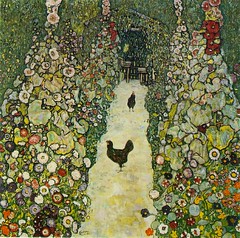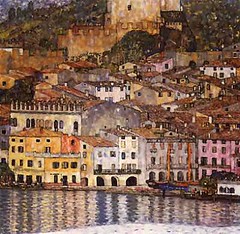We went to the opera last night! How fun! Another great homeschool field trip. I find I have a lot to say about this opera. So I'm going to split it up, beginning with a (relatively) brief discussion of the plot.
Synopsis as apprehended by a spectator with no prior knowledge of the opera:
Someone is walking around, when he is menaced by a huge monster. He faints in terror. Three women come and kill the monster. They decided the guy is cute, and after exclaiming about this for a while, decide to go tell the queen in the hopes that this will cheer her up, because she is apparently unhappy about something. After they leave, a bird-like person appears. He sings about how great a bird-catcher he is, but his song gradually changes to reveal his deep longing for love and a wife. The guy recovers from his faint, the three women come back, the Queen of the Night appears. She sings about how her daughter was kidnapped by the magician Sarastro, and that this guy, now revealed as a prince, should go rescue her. She gives the prince a magic flute, the bird guy some magic bells, and also tells them that three boys in a boat that flies through the air will accompany them and give them advice, which they should follow. So they set off.
For some reason, Papageno (the bird guy) immediately arrives at the place where the princess (Pamina) is being held captive, and they escape. The prince (Tamino), however, wanders around until he comes to some temples, where a priest informs him that Sarastro is their benevolent leader, and the Queen of the Night is no good. Papageno and Pamina are re-captured, Sarastro refuses to release her, Tamino shows up and it is decided that Tamino and Papagena will be initiated into the temple (oh, by the way, it turns out they're in Egypt) and earn the love of their women (it is hinted, although we don't see her, that there is a bird woman for Papageno around somewhere).
Tamino and Papageno enter the temple. The Queen of the Night appears to her daughter and gives her a knife, telling her to kill Sarastro. Tamino passes his tests, Papageno fails his. Papageno is on the verge of suicide, but the bird woman, Papagena, comes to him and saves him. Tamino and Pamina go through fire and water protected by the magic flute. The Queen of the Night appears and sings about how she's going to conquer everybody, but then without notice sings instead that she is conquered. She leaves with her three handmaidens. There is a big triumphal ending.
I've been reading about how this is witty and profound, but my initial impression was more that it was disjointed and lacking in sense. If the Queen of the Night is so evil, how come she gives Tamino the magic flute, which is good, and sends the three boys to give him advice? If Sarastro is good, why did he kidnap Pamina? Plus, why are we supposed to all of a sudden believe the followers of Sarastro about who is good and who is bad? Yet, apparently, this is not a plot twist, but a revelation of truth.
Now that I think of it, there were some funny lines. I can't help thinking they were probably funnier in 1791 when this opera was composed, and people didn't get around so much. 216 years later, they're amusing, but a little shopworn.
So, if you're still reading, here is the synopsis from SFO's website:
ACT I
Tamino, a prince from a far country, is seeking the court of the Queen of the Night. As he nears his goal he is attacked by a dragon, but three ladies in the service of the Queen save Tamino and hurry off to inform their mistress of his arrival. Papageno, a bird catcher, bounces in and proclaims that he has slain the dragon.
The ladies soon return and, after punishing Papageno for lying, give Tamino a portrait of the Queen’s daughter Pamina, who has been enslaved by the evil Sarastro. Tamino falls in love with her instantly and offers to rescue her. The Queen suddenly appears and describes the grievous loss of her daughter. She confirms Tamino in the task of returning Pamina and promises to make her his bride.
The ladies instruct Papageno to accompany Tamino on his journey. Each receives a magic musical instrument for use in time of trouble: a flute for Tamino and a set of silver bells for Papageno. Finally, the ladies summon three wise boys to guide them to the tyrant’s lair.
Meanwhile Pamina bravely tries to escape from her captivity, but she is intercepted by the slave master Monostatos. He intends to rape her, but is thwarted by Papageno, who has been sent ahead by Tamino to scout Sarastro’s citadel. Papageno reassures Pamina that help is on the way and releases her from her chains.
The three boys have led Tamino to the threshold of Sarastro’s realm where the prince is confronted by three doors. Tamino demands admission and the speaker of the temple informs Tamino that he has been misled by the Queen of the Night. True, Sarastro has abducted Pamina, but he is not an evil tyrant. If Tamino wishes to discover the whole truth and find Pamina, he must undergo initiation to the temple. Mysterious voices assure him that Pamina is still alive. In gratitude, Tamino plays his magic flute for the first time. Wild beasts assemble to listen to the flute, but they disperse at the sound of Papageno’s pipes.
Upon hearing the pipes, Tamino goes off in search of Papageno, who arrives immediately from another direction with Pamina. They are again apprehended by Monostatos. This time the silver bells get them out of trouble, but by now it is too late, for Sarastro himself has arrived with his entourage.
Pamina confesses to the attempted escape, using Monostatos’s lust as her reason. Sarastro forgives Pamina but dismisses her love for her wicked mother. Pamina must now transfer that love to a man. At this moment she sees Tamino for the first time, led in under arrest by Monostatos. She recognizes him at once as the man she is destined for, and they rush into each other’s arms. Sarastro gives orders for Tamino and Papageno to be initiated into the mysteries of the temple.
ACT II
Tamino is accepted as a suitable candidate for the brotherhood. Sarastro sees Tamino’s recruitment and marriage with Pamina as decisive in the power struggle with the Queen of the Night. Tamino goes unflinchingly through his trials, culminating in the ordeals by fire and water. He is accompanied by Pamina through the ordeals, but not before she too has her faith in Tamino and Sarastro sorely tried—first by her mother and later by Tamino himself, whose vow of silence she misinterprets as rejection. Papageno has a very difficult time with his trials and doesn't make it through. He is frightened of the dark, talks throughout the trial of silence, is separated from Tamino, and gets lost in the temple. He didn’t wish to undergo the initiation in the first place, and his interest is only kept alive by the prospect of finding the wife promised to him by Sarastro. Papageno’s wife-to-be, Papagena, seems to be propelled to him by the power of music and eventually turns him from suicide to a fulfilling life with her.
In the end, Sarastro's strategy successfully annihilates the Queen of the Night's power as the people hail Isis, Osiris, and the triumph of courage, virtue, and wisdom.
And if you've really got stamina, there is an
excellent synopsis on Wikipedia.
For my money, even when written up by someone who knows the opera, this plot makes no sense. Good thing Mozart writes such beautiful music. So, just like an opera, in fact, I have taken a huge number of words to say only: Nice music, but the plot makes no sense at all. Even for an opera. So little sense that I feel compelled to go on and on about how little sense it makes. But I'm going to stop now. Really.
Labels: field trips




















